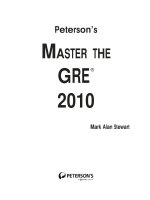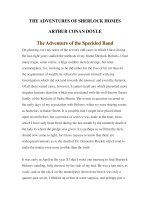The EQ interview finding employees high emotional intelligence part 1 doc
Bạn đang xem bản rút gọn của tài liệu. Xem và tải ngay bản đầy đủ của tài liệu tại đây (549.41 KB, 10 trang )
Advance praise for
The EQ Interview
“Adele Lynn’s newest book, destined to be a bestseller, captures the
vital importance and necessity of behavioral interviewing for emo-
tional intelligence. I find myself not being able to put this book down!”
—John Dickson, President and CEO, Redstone SeniorCare
“Selecting the right candidate is critical. Without question, The EQ
Interview will enable me to make far more intelligent and informed
hiring decisions.”
—Bill Abbate, Director, Excell Technologies
“The great challenge of recruiters is how to identify emotional intelli-
gence in potential candidates. The EQ Interview gives us a practical guide
and excellent tool to identify professionals with these skills.”
—Lúcia Helena M. Meili, Human Resources Director,
MPD Engenharia, São Paulo, Brazil
“Using the tools in The EQ Interview, recruiters and hiring managers
will get a more complete view of a candidate’s qualifications, which is
sure to result in better hiring decisions.”
—Jane Patterson, President, Begin Again Group, Inc.
“When the concepts outlined in this book are done correctly, the hir-
ing manager and/or recruiter can directly influence the overall morale,
teaming, interpersonal as well as organizational effectiveness and pro-
ductivity of the organization.”
—Franky Johnson, Johnson & Lee Consulting, LLC
“The EQ Interview is an essential resource for managers in all sectors of
the economy.”
—Darlene Bigler, Executive Director, Community
Action Southwest
“The EQ Interview captures the backbone of competencies that organi-
zations must have in order to provide high quality services in today’s
society.”
—S. Doug Kovach, Director, Head Start, Southwestern PA
“The EQ Interview by Adele Lynn is of great importance to guide the
hiring professional. It drives the interview to be more objective about
emotional intelligence.”
—Glauce Gravena, Director, Multi-National
Fortune 500 Company, São Paulo, Brazil
Finding Employees
with High Emotional Intelligence
Adele B. Lynn
American Management Association
New York • Atlanta • Brussels • Chicago • Mexico City • San Francisco
Shanghai • Tokyo • Toronto • Washington, D.C.
The EQ Interview
Special discounts on bulk quantities of AMACOM books are available to
corporations, professional associations, and other organizations. For details,
contact Special Sales Department, AMACOM, a division of American Manage-
ment Association, 1601 Broadway, New York, NY 10019. Tel: 212-903-8316.
Fax: 212-903-8083.
E-mail:
Website: www.amacombooks.org/go/specialsales
To view all AMACOM titles go to: www.amacombooks.org
This publication is designed to provide accurate and authoritative informa-
tion in regard to the subject matter covered. It is sold with the understanding
that the publisher is not engaged in rendering legal, accounting, or other pro-
fessional service. If legal advice or other expert assistance is required, the ser-
vices of a competent professional person should be sought.
Library of Congress Cataloging-in-Publication Data
Lynn, Adele B.
The EQ interview : finding employees with high emotional
intelligence / Adele B. Lynn.
p. cm.
Includes index.
ISBN 978-0-8144-0941-1
1. Employee selection. 2. Emotional intelligence—Examinations,
questions, etc. 3. Core competencies. 4. Employment interviewing.
5. Work—Psychological aspects. I. Title. II. Title: Employees with
high emotional intelligence.
HF5549.5.S38L96 2008
658.3′1125—dc22
2008001437
© 2008 Adele B. Lynn
All rights reserved.
Printed in the United States of America.
The Society for Human Resource Management (SHRM) is the world’s largest professional
association devoted to human resource management. Our mission is to serve the needs of
HR professionals by providing the most current and comprehensive resources, and to ad-
vance the profession by promoting HR’s essential, strategic role. Founded in 1948, SHRM
represents more than 230,000 individual members in over 125 countries, and has a net-
work of more than 575 affiliated chapters in the United States, as well as offices in China
and India. Visit SHRM at www.shrm.org.
This publication may not be reproduced, stored in a retrieval system, or trans-
mitted in whole or in part, in any form or by any means, electronic, mechanical,
photocopying, recording, or otherwise, without the prior written permission of
AMACOM, a division of American Management Association, 1601 Broadway, New
York, NY 10019.
P
RINTING NUMBER
10987654321
CONTENTS
1 Introduction 1
2 The Five Areas of Emotional Intelligence
and the EQ Job Competencies 7
3 Self-Awareness 15
Competency 1: Impact on Others 16
Competency 2: Emotional and Inner Awareness 20
Competency 3: Accurate Assessment of Skills
and Abilities 26
4 Self-Control or Self-Management 33
Competency 1: Emotional Expression 35
Competency 2: Courage or Assertiveness 39
Competency 3: Resilience 42
Competency 4: Planning the Tone of Conversations 47
5 Empathy 53
Competency 1: Respectful Listening 54
Competency 2: Feeling the Impact on Others 56
Competency 3: Service Orientation 58
6 Social Expertness 65
Competency 1: Building Relationships 68
Competency 2: Collaboration 71
Competency 3: Conflict Resolution 74
Competency 4: Organizational Savvy 78
v
7 Personal Influence: Influencing Self 85
Competency 1: Self-Confidence 86
Competency 2: Initiative and Accountability 91
Competency 3: Goal Orientation 94
Competency 4: Optimism 98
Competency 5: Flexibility and Adaptability 101
8 Personal Influence: Influencing Others 111
Competency 1: Leading Others 112
Competency 2: Creating a Positive Work Climate 116
Competency 3: Getting Results Through Others 121
9 Mastery of Purpose and Vision 129
Competency 1: Understanding One’s Purpose and Values 130
Competency 2: Taking Actions Toward One’s Purpose 133
Competency 3: Authenticity 135
10 The EQ Fraud and Other Warning Signs 141
All One-Sided: Too Good to Be True 142
Other Behavior Trends 146
A Word About Instinct 151
11 A Final Word 153
Appendix 1. Emotional Intelligence Table
of Competencies 157
Appendix 2. Questions by Area and Competencies 161
Index 181
About the Author 185
vi CONTENTS
CHAPTER 1
Introduction
1
F
undamental emotional intelligence (EQ) competencies lie beneath
great performance for nearly every job tackled by today’s work-
force. For a hiring manager or interviewer, including these competen-
cies as part of the interview process begs consideration. We’re not
suggesting that technical skills and abilities be taken for granted. Skills
and technical competence must always serve a prominent role in the
assessment process. However, a growing body of evidence points to
the fact that when technical competencies are equal, EQ competen-
cies account for job success in many different positions. In fact, for
some positions, EQ competencies account for a larger portion of job
success than technical competencies. Leadership IQ, a training and re-
search center that teaches executive and management best practices,
conducted a study of more than twenty thousand employees that
tracked the success and failure of new hires. After interviewing 5,247
managers, the study’s researchers concluded that only 11 percent of
employees failed because they lacked the technical competence to do
the job. The remaining reasons new hires failed were issues such as
alienating coworkers, being unable to accept feedback, lack of ability
to manage emotions, lack of motivation or drive, and poor interper-
sonal skills.
1
These results provide a good indication that including
comprehensive EQ competencies as part of the interview process gives
hiring managers and interviewers access to new and critical informa-
tion to predict a candidate’s effectiveness.
As baby boomers become eligible for retirement and begin to exit
the workforce, employers grapple with how to hire and train enough
workers to fill the void. According to the Bureau of Labor Statistics,
20 percent of the workforce will be over age fifty-five by 2010. In
2004, the number of people age forty and older in the workforce is
over 56 percent.
2
Companies face large numbers of new hires who
will view the organization much differently than do the employees
who are leaving. Commitment and retention will be a challenge be-
cause these new hires will have little invested in a company. As a re-
sult, they will have little incentive to stay for the long term if they
receive a more lucrative offer from another firm. If the hiring com-
pany doesn’t meet the new hire’s expectations, that new hire will
leave—causing an endless hiring-resignation cycle and a resultant gap
in the skills and abilities needed for the company to compete. And
this cycle will prove costly. Turnover costs range from 120 to 200 per-
cent of annual salary, and new employee performance takes thirteen
months to reach maximum efficiency. These statistics offer another
compelling reason to screen for emotional intelligence competencies.
Organizational commitment and retention are closely linked to emo-
tional intelligence.
3
Few would argue that commitment and retention
are not useful traits. Retention links directly to job satisfaction. Job
satisfaction is related to self-esteem, emotional stability, and consci-
entiousness.
4
The emotional intelligence model in this book takes all
of these elements into consideration.
To address and plan for future manpower needs, organizations
perform skills audits that take into account the technical skills that
will be needed once the baby boomers exit. Granted, hiring and train-
ing people for technical skills begins to fill the technical void or brain
drain, but since various studies estimate that emotional intelligence
competencies account for anywhere from 24 to 69 percent of perfor-
mance success, companies waste their recruitment efforts if they don’t
consider screening methods aimed at a candidate’s emotional intelli-
gence.
5
In addition to auditing the technical gap, companies must
begin to audit and map the skills and competencies beyond technical
excellence that drive the organization’s success. What defines a com-
pany’s outstanding service orientation? What makes a company nim-
ble enough to act on market-driven changes? What inspires the
innovation and creativity that keep a company competitive? What
forces drive the integrity of and trust in a brand? These are not tech-
nical competencies by nature. Although technical excellence is a com-
2 THE EQ INTERVIEW
petitive factor that can’t be ignored, the competencies that drive these
intangible market advantages are propelled by the very core, or fun-
damental, competencies that define how a company does things.
The organization’s objective becomes hiring people who can de-
liver the how consistent with the company’s success. The interview
process gives the hiring manager and interviewer a unique opportunity
to determine how people accomplish results, not just what they ac-
complish. This insight into how people accomplish results allows the
hiring manager and interviewer to assess whether or not the person
will fit within the organization. They can assess whether the potential
new hire will contribute in a way that aligns with the organization’s
values and behave in a way that is consistent with the company’s com-
petitive advantage—or whether the candidate’s behavior will collide
with the organization’s goals. Poor fit is one of the three most likely
causes of employee turnover.
6
Research suggests that fit, not skill or ed-
ucation, is the most common reason people fail. Fit also plays a signif-
icant role in turnover due to job dissatisfaction.
This book assists hiring managers and interviewers to assess EQ
competencies. It gives hiring managers and interviewers a description
of each of the EQ competencies, examples of the EQ competencies in
the workplace in various types of jobs, interview questions for each of
the EQ competencies, and analyses of responses to the suggested ques-
tions. With these tools, hiring managers and interviewers can evalu-
ate and construct an interview plan that gives them a more complete
picture of the candidates’ abilities to succeed.
Not all jobs require all the EQ competencies covered in this
book. However, because emotional intelligence is so fundamental to
our ability to interact with people, many jobs require at least some
of these competencies. The hiring manager and interviewer must
decide which competencies contribute to success in the position
they are hiring for. Then the hiring manager or interviewer should
select interview questions that represent these competencies. Some
of the questions in this book are aimed at managers or leaders; how-
ever, most are acceptable for all job levels. We encourage the inter-
viewer and hiring manager to record the questions asked as well as
the responses. If multiple candidates are to be interviewed, a consis-
tent approach and consistent questions produce the most unbiased
results.
INTRODUCTION 3









